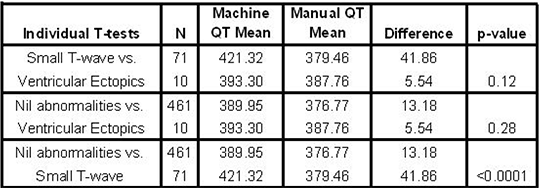Measurement of QT Interval in Poisoned Patients With Acquired Long QT syndrome: Sources Of Measurement Error and Effects of Various Treatments. Introduction: Many different drugs are known to prolong the QT interval in toxicity. Current TOXBASE® recommendations include the manual measurement of QT if prolongation is suspected, and treatment with IV magnesium sulphate (MgSO4) if QT prolongation is confirmed(1,2). This reduces the risk of ventricular tachycardias, but does not reduce the QT interval per se (2,3). QT prolongation in poisoned patients is sometimes associated with increased QRS duration, and the latter is treated with sodium bicarbonate (NaHCO3). We tested the extent of error in automated measurement of QT by ECG machines compared to manual calliper estimates, and the effect of ventricular extrasystoles (VEs) and small T waves (amplitude <0.5 mm) on this. We also analysed the effects of MgSO4 and NaHCO3 on QT and QRS. Methods: The ECGs of all patients poisoned with QT-prolonging drugs were prospectively collected from August 2011 to February 2012, along with details about drugs ingested, treatments given, and any adverse events experienced. QRS, QT and heart rate reported by the ECG machine were obtained. QT was also manually measured with digital callipers, and compared to machine values. We measured the change over time of QRS and QT in patients receiving MgSO4 and NaHCO3 compared to untreated patients with similar initial QT intervals. Differences between groups were analysed by Student’s t-test or ANOVA as appropriate.  
Results: There were a total of 542 ECGs in 227 patients. Of these, 10 received HCO3, 8 received MgSO4, and one patient received both. Mean QT was significantly lower when measured manually compared to machine estimate (377 vs. 394ms, p<0.0001). This discrepancy was increased by the presence of small T-waves but not ventricular extrasystoles (VE), though there were few cases of VE in our population (Table 1). NaHCO3 significantly reduced both QRS and QT interval, while MgSO4 did not (Table 2). As there were no ventricular arrhythmias in our study cohort, we cannot comment on the efficacy of either machine or manual QT measurement at predicting this. Conclusions: ECG machines overestimate QT by around 40 ms when T wave amplitude is less than 0.5 mm, and by ~20ms otherwise. NaHCO3, but not MgSO4, significantly reduced QRS and QT; so there may be a role for NaHCO3 administration in long QT syndromes, but this effect needs to be further explored. References: 1. Chan A et al, Q J Med 100:609, 2007. 2. Kahn IA, Am Heart J 143:7, 2002. 3. ACC/AHA/ESC Guidelines for management of patients with ventricular arrhythmias and the prevention of sudden cardiac death. Europace 8:746, 2006.
|



